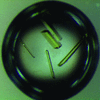issue contents
May 2012 issue

Cover illustration: Hansenula polymorpha copper amine oxidase-1 in complex with CoII (Klema et al., p. 501).
structural communications
The structure of copper amine oxidase 1 from H. polymorpha in its metal-free precursor (apo) form is reported along with structures of the apo protein in complex with CuI and CoII.
Open  access
access
 access
accessHexameric rings of RadA recombinase from M. voltae have been crystallized. Structural comparisons suggest that homologues of RadA tend to form double-ringed assemblies.
PDB reference: RadA recombinase, 4dc9
A new crystal structure of yeast Rpn14 with an E384A mutation was determined at 1.6 Å resolution. The improved high-resolution structure provides a framework for understanding proteasome assembly.
PDB reference: yeast Rpn14 E384A mutant, 3vl1
The crystal structure of the C61S mutant of Tpx from E. coli is reported at 1.97 Å resolution. A brief structural comparison with homologues is presented.
PDB reference: C61S mutant of Tpx, 4af2
The structure of the catalytic chain of Methanococcus jannaschii aspartate transcarbamoylase has been determined in a hexagonal crystal form and gives insight into the possible paths that the substrate carbamoyl phosphate may follow to reach the active site during catalysis.
PDB reference: aspartate transcarbamoylase catalytic chain, 4ekn
crystallization communications
Initial crystallographic studies of the X. fastidiosa small heat-shock protein HSP17.9 are reported.
Carbonyl reductase S1 from C. magnoliae was expressed, purified and crystallized. The crystals obtained diffracted X-rays to 1.90 Å resolution and belonged to space group P6122 or P6522.
A cell membrane permeable SOD, SOD-TAT fusion protein, was expressed, purified and crystallized. X-ray diffraction data have been collected to 3.2 Å resolution.
A novel hyperactive antifreeze protein from R. inquisitor (RiAFP) has been overexpressed, purified and crystallized. A complete native X-ray diffraction data set was recorded to 1.3 Å resolution.
3-Ketosteroid Δ1-dehydrogenase from Rhodococcus erythropolis SQ1 was successfully crystallized and its initial structure was solved.
The MsrA domain of MsrAB from H. influenzae was crystallized. X-ray diffraction data were collected to 1.6 Å resolution.
Esterase A from C. crescentus CB15 was crystallized in space group C2221 and diffraction data were collected to a resolution of 1.62 Å.
Two hypothetical ribose-5-phosphate isomerases from S. mutans have been produced in E. coli and crystallized. The crystals diffracted to high resolutions suitable for crystallographic analyses.
The Crimean–Congo haemorrhagic fever virus nucleocapsid protein was expressed in E. coli, purified and crystallized. X-ray diffraction data were collected to 2.1 Å resolution.
A trypsin-resistant catalytic domain of human calcineurin α (A subunit, residues 20–347) was crystallized in space group P21212. An X-ray diffraction data set was collected to 2.87 Å resolution and the structure was solved by molecular replacement.
Open  access
access
 access
accessThe major capsid proteins VP16 and VP17 of bacteriophage P23-77 have been crystallized using both recombinant and purified virus and preliminary diffraction analyses have been performed.
The expression, purification and crystallization of the alginate lyase AlgL from P. aeruginosa is described. The crystals diffracted to a resolution of 1.64 Å.
Crystals of hydroquinone dioxygenase from Sphingomonas sp. strain TTNP3 belonged to space group P21 and contained two heterotetramers in the asymmetric unit related by 222 noncrystallographic symmetry. X-ray data were collected to a maximum resolution of 2.5 Å using a synchrotron source.
The crystallization and preliminary X-ray diffraction analysis of a novel chloromuconolactone dehalogenase from R. opacus 1CP are described. The oligomeric state was determined based on the self-rotation function.
laboratory communications
The utility of differential scanning fluorimetry for homogeneity assessment and crystallization improvement of PLP-dependent enzymes is demonstrated using the potential drug target BioA from M. tuberculosis.
An on-column ligand- and detergent-exchange method was developed to obtain ligand–protein complexes for an adamantane series of compounds with 11β-HSD1 after a variety of other complexation methods had failed. An interesting byproduct of the method was the observation of artificial trimers in the crystal structures.
Addition of protease instead of seeds using a robot can be used to optimize the concentration of protease in in situ proteolysis experiments and has been successfully tested using two proteins.


 journal menu
journal menu

































![[publBio]](/logos/publbio.gif)





